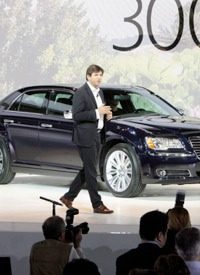
Despite ending 2010 with a $652 million net loss, Sergio Marchionne, Chrysler’s chief executive officer, was determinedly optimistic, even though the company didn’t meet its net revenue objectives, and had to shut down some of its factories in December, despite providing more than $3,600 in vehicle incentives to move its older models off the showroom floors.
But all of this is somehow good. Said Marchionne,
As Chrysler Groups brand displays at the Detroit auto show confirmed, the company has lived up to its expectations to launch 16 all-new or significantly refreshed vehicles in the next 12 months.
All of these vehicles bear testimony to Chrysler’s rebirth. Given the positive comments we have received to date, it can safely be said that what Chrysler delivered last year, on both the product and financial fronts, surpassed many expectations.
However, our job is not yet done. We have a lot of work ahead to fulfill our five-year business plan objectives.
A lot of work indeed. Chrysler’s overly heavy reliance on the sales of SUVs and trucks in an era of increasing gas prices, its commitment to launch the Fiat dealership network (Fiat owns 25 percent of Chrysler, soon to be 51 percent), and its high interest costs in servicing the TARP loans it received from the government in its bankruptcy in 2008, will make actual survival of the company an iffy proposition indeed.
Part of Marchionne’s strategy is to borrow some more money from the government at low interest rates and then use that money to repay other government loans that are bearing higher interest rates. In fact, Chrysler’s application for $3 billion in loans from the Department of Energy to help improve the company’s fuel efficiency numbers (they are lowest among the majors) has been pending since 2009, with no indication that that financing will be completed anytime soon. Today Chrysler pays 7.22 percent interest on more than $2 billion owed to the government, and 10.55 percent interest on another loan of $3.54 billion. If the doubtful application is approved, savings in interest to the government would exceed $500 million annually, which would, on paper at least, make the company appear to be profitable. And that would aid in the company’s efforts to “go public” later this year through an Initial Public Offering (IPO) of its stock to investors.
Chrysler has gotten way behind in the technology race, and the loan of new money to pay back the old is crucial to its continuing attempts to catch up. Patrick O’Keefe, a financial transactions consultant to the auto industry, confirmed: “They’re way behind the eight ball and technology keeps changing. It’s hard to play catch up.” Even Marchionne admits that, if the new loans aren’t approved, he may have to ask for some more financial assistance from Fiat: “There is a point in time when I need to go back to my kitty and start using the other [Fiat] cash to do this, which is not a good answer.”
In other words, without putting too fine a point on it, if the new loans aren’t granted, then Fiat would have to invest more of its own money into the failing automaker just to keep it afloat until the 2011 “new and refreshed” models hit the showroom floors. But that is a last resort — it’s always better to use someone else’s money if one can get it.
Especially when it comes to paying out bonuses. Said Marchionne, when making the announcement that each employee would receive $750 as a “performance award” (it couldn’t be called profit-sharing, naturally), he said, "It would have been inexcusable to not recognize what our people have done. 2011 is the year of execution. We will be bottom-line profitable in 2011."
At the end of 2010 Chrysler’s gross debt was $13.1 billion, an increase of $1.1 billion from September, due primarily to a loan the company was able to receive from its Canadian retiree health care trust. Encouraged by the bonuses “awarded” to its union members, UAW President Bob King gushed:
[I am] pleased at the turnaround that Chrysler and the other automakers have made. The dedication and hard work of UAW members at Chrysler have contributed greatly to this success, and we appreciate the company’s recognition of the contribution made by [its] employees. We are convinced that Chrysler has a great future and look forward to more opportunities for our members to share in that success.
This was dutifully echoed by Canadian Auto Workers union president Ken Lewenza: “Chrysler is on the right track and gaining momentum with our new products, and I expect this success to continue into 2011.”
In summary, then, Chrysler hasn’t made a profit, is paying very high interest rates on money it borrowed from the U.S. taxpayer through the federal government, it has 16 new or refreshed vehicles (most of which will be successfully ignored by millions watching the Super Bowl), had the chutzpah to celebrate its success by paying out “performance awards” to its union members, and is hoping to be bailed out once again with another infusion of government cash (or more loans from its partner, Fiat) before the company itself runs out of money. And this is called success.
In the real world, such behavior would be rewarded by investors calling in their loans, customers shunning their products, and a liquidation of the company with its assets being sold off to other interests who know how to run an auto manufacturer profitably. That’s the way the free market, when it is allowed to operate, works. Successful use of capital is rewarded. Unsuccessful capital is reallocated to a higher and better use. In the make-believe Chrysler world, however, failure is called success, extractions from taxpayers to keep the company solvent are called “investments,” and its employees receive “performance awards.”
Photo of Chrysler 300 Series: AP Images



